The Volcán de Colima most recently erupted in early 2019, spewing fire and volcanic ash up to 13k feet above the crater. Our friend Pancho was camping on its steep slope when the eruption first started. “I heard this deep sub-surface crack,” he told us. “Like a bone breaking far beneath the ground we were standing on.”
Also known as El Volcán de Fuego de Colima, it’s one of the most active volcanoes in all of North America, and has erupted repeatedly over the past several decades. The volcano is monitored closely by Mexican authorities and nearby communities are often evacuated during eruptions. The area around the volcano is known for its scenic beauty, including lush forests and rolling hills, as well as its abundant wildlife, including several species of endemic birds.
The city of Guadalajara, Jalisco is a mere 78 miles from the caldera. Large lime and avocado agricultural operations are scattered around the flat base of the volcano before the hills climb high into the clouds. There are a few roads that switchback their way up the steep slopes. As you traverse through the pine-forest-lined roadways, you can spot the occasional small homestead or rural mountain farm.
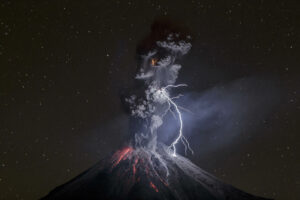
Perhaps the most famous photo of the Volcán de Colima, taken by Sergio Tapiro during a 2015 eruption, perfectly capturing a lightning strike extending from the volcanic blast. Chacolo is produced just a few miles from this volcano.
Only a certain type of person will live beside an active volcano. It takes a different mindset, knowing that at any time, the volcano could blast basaltic lava fountains in your direction. I don’t totally understand it. It’s part romantic, part cavalier, and little crazy, but it’s what this certain type of person chooses each day. They continue to reside in the beautiful, yet potentially catastrophic, shadow of a natural wonder that could easily destroy everything around them.
The Partida family has been making that exact decision for generations, continuing to live beneath Colima through its frequent eruptions. Not only do they live and farm in the shadow of the Volcán de Colima, this is where they produce their world-class agave spirits for their family-owned brand, Chacolo.
Chacolo Agaves and Minerality
Anyone who has tasted Chacolo will note that the mezcal has a distinct minerality. Perhaps this is a direct connection to the minerals that the Volcán de Colima has been pulling from deep within the Earth and spreading over the area for the last several centuries. The Partida family doesn’t buy agaves. They only use what is fully matured in their fields. The agaves used in production are always capon, meaning that they’ve all been castrated upon reaching maturity, allowing the sugars to concentrate in piña. Normally, the quiote of the agave would grow tall and begin flowering as it reached toward the sky as part of it’s reproductive cycle. Cutting the quiote at the time of maturity allows for the sugars to concentrate in the heart of the agave, which is what is used for mezcal production.
In total, they cultivate 15 different maguey varietals, which they have been collecting from the region for three generations. These varietals include 14 Agave angustifolia sub varietals and 1 Agave rhodacantha sub varietal. The Partidas are vehemently against monoculture, so they seasonally grow wild tomatoes, chiles, corn, beans and squash in rows between the massive agaves that are scattered around their property. This biodiversity continually improves the soil, and makes all of the plants much stronger. The family doesn’t just grow agave, they legitimately live off the land.
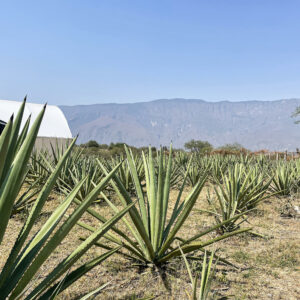
One of the many fields in which Chacolo grows their agave. During the rainier seasons, the rows between the agave are filled with other crops.
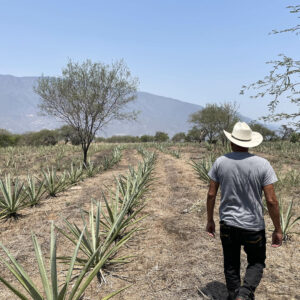
Miguel walking us around the fields and showing us the differences between the 14 Agave angustifolia sub varietals his family cultivates.
Living in Jalisco and using these rare agave varietals, Chacolo doesn’t meet the qualifications for the Tequila Denomination of Origin, nor the Mezcal Denomination of Origin. They seem to be ok with this, and will still call their distilled agave “mezcal” in conversation. You’ll see their bottles do not use the word “mezcal” for legal purposes, but that’s what the family calls it.
Visiting Chacolo
We had the opportunity to visit with Miguel Partida at the family’s taberna in Zapotitlan de Vadillo, Jalisco this past year. Our friend Pancho picked us up in Guadelajara and we drove out through the dry lake beds, massive agricultural operations, and up through the pine forests that line the roads that zigzag over the Volcán de Colima.
Miguel met us near the wooden fermentation tanks. The name you see on Chacolo bottles is Maestro Tabernero Don Macario Partida Ramos. Miguel is his son, who seems to be doing most of the production at the taberna nowadays. He’s a 5th generation maestro, and he’s been working with agave spirits for almost all of his life. He’s reserved, even-keel, and a dedicated skateboarder when he can find the time.
He walked us over to the underground pit oven that they use to cook the agave. He explained that they use both river stones and volcanic stones for the oven. The river stones can get too hot and explode. Having both types of stones distributes heat better and gives them a more even cook. For them, a 5 ton oven full of agave cooks for 4 days, with them adding 5 buckets of water after the first 2 days in order to create more steam.
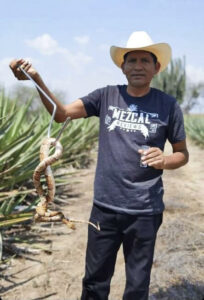
Miguel creating what is undoubtedly the most badass advertisement for a Mezcal Reviews t-shirt, holding a mezcal in one hand, and a snake in the other. Think you can outdo him? Grab a shirt at Agaveholics.com and show us how!
If there are enough people at the taberna during production, they will mash all the agaves by hand with mallets. If not, they use a mechanical shredder to mill the cooked agaves. Fermentation in this region takes a long time due to the high altitude and low temperatures at night. The Partidas use two different methods to ferment their milled agave: they have wooden fermentation tanks, and they also have 1500 liter underground stone fermentation pits. For the wooden fermentation tanks, they do 3-4 days of dry fermentation, and then another 20 days of fermentation with well water added. The underground stone fermentation pits provide a slightly faster fermentation. Miguel estimated these to take about 18 days to ferment as the temperature in the underground pits is more consistent. Regardless of how the agaves are fermented, they use the same high-mineral well water to fill the fermentation tanks.
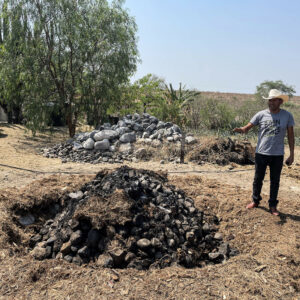
Miguel showing off the underground pit oven that they use to cook the agave for all of their mezcales.
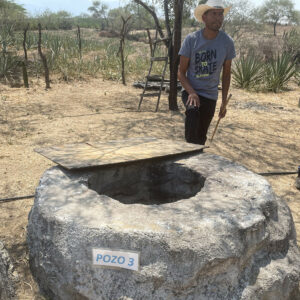
One of the underground fermentation pits that are used for some of their batches. Other batches use large wooden fermentation tubs.
So if their mezcal is known for it’s high minerality, where does that high-minerality come from? Is it fermenting their agaves in this high-mineral water that gives their mezcal that uniquely clean minerality? Is it the chalky soil in which the agaves grow for years? Maybe both? As National Geographic reports, “soil near active volcanoes is often rich in mineral deposits and provides excellent farming opportunities.” Discovery also reports this in their article Why Do People Live Near Active Volcanoes?, “If you remember your fifth-grade science class, the molten rock that pours forth during a volcanic eruption is known as magma when it’s underground and lava once it reaches the surface. The thing about magma coming up from below ground is that it takes other things up with it — things like valuable minerals and nutrients that are then broken down to make the soil extra fertile.” Sipping Chacolo is tasting the volcanic elements of the land. You’re tasting what the volcano pulled from deep inside the earth.
The Partidas use sections of Parota tree trunks to build their Filipino stills. These stills can be used for up for 4-5 years before they dry, crack, and need to be replaced. Keep in mind, however, that 4-5 years for the Partidas doesn’t necessarily mean that the stills are getting a lot of use. They only produce a few thousand liters per year.
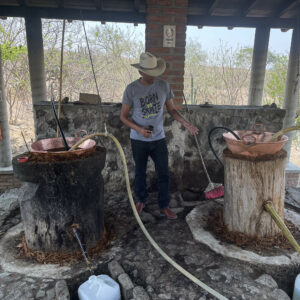
Miguel with the two stills that are used to distill all of Chacolo’s mezcal.
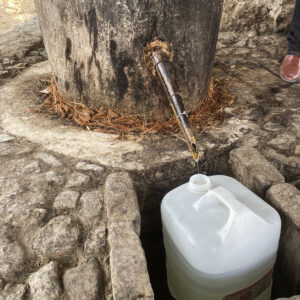
One of the stills with mezcal running out through an agave penca and into a jug.
Miguel walked us through his fields as well. They’re a mix of agaves and other crops to promote biodiversity and soil health. They’ve also found that ant nests actually help their agaves grow larger and with more sugar. Miguel told us about some agaves that were recently harvested at 100 kilos larger than expected, and they had large ant nests in their roots. This is contrary to popular belief as many agave farmers will work to remove ant nests from their fields. Again, the Partidas are true stewards of this wild land.
The Horn
We’d be remiss if we didn’t mention the horn. Our friends William and Philipp at Heavy Metl Imports (the team that imports Chacolo into the US, truly heavenly work) have been telling us about the horn for years. We finished our tour of the taberna at a small outdoor tasting bar. Miguel pulled out several of his family’s releases and we began tasting.
After tasting a few rounds of mezcal in glass veladoras, Miguel reached down under the bar and pulled out a horn, the horn. He filled the horn with some of his personal favorite mezcal, Chacolo Ixteco Amarillo, the family’s one and only Agave rhodacantha. The funny thing about drinking from a horn is that there’s no way to put it down. Once it’s filled and being passed around the circle, there’s no way out. You have to drink whatever is in the horn before anyone can put it down.
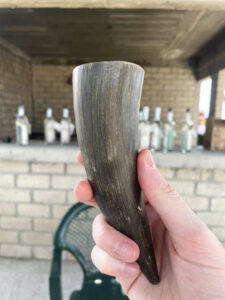
The Chacolo horn. Once filled, you can’t put this down until it’s empty.
Needless to say, we finished the Ixtero Amarillo in the horn, as well as all of the other mezcals that were poured into the horn after that. Highly elated and slightly tipsy, we wandered back out into the field to admire the mountainous landscape.
Whatever It Takes
The region surrounding the Partida family’s land is immense and beautiful. It’s this land, wild and humbling in its magnitude, that comes through in their mezcal. To live in the shadow of one of the most active volcanoes in all of North America takes a special type of person. Whatever it is that makes someone wake up each morning, and continually choose to live beneath an active volcano, to build their life and their legacy on that edge, and continue to push forward… whatever that is, we’re happy that the Partida family continues to carry that gene from one generation to the next, producing mezcal in the shadow of the Volcán de Colima.


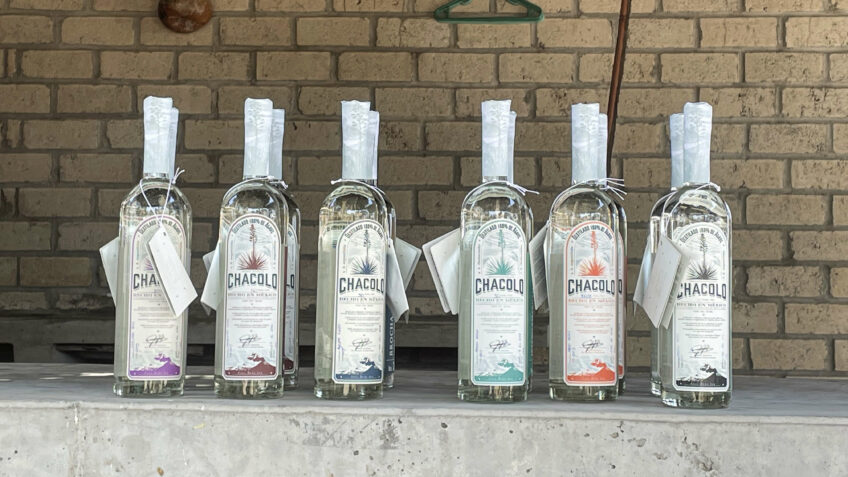


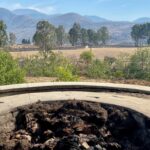
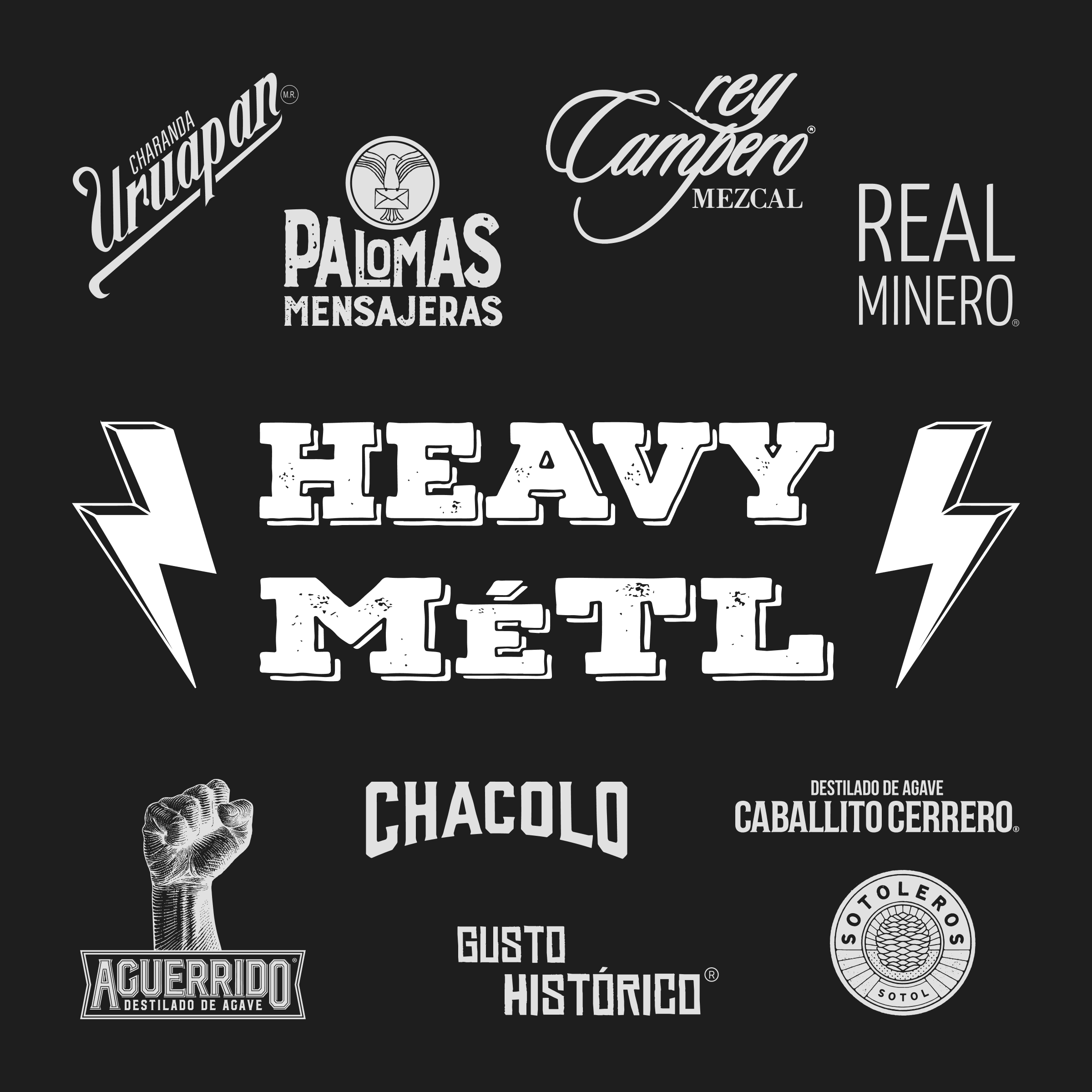
aarild
2 years agoThanks for a most interesting read! I’ve had a couple of their expressions, and it is astonishing how diverse flavour profiles they get out of one agave species. I’d love to try more from them, so it’s a great inspiration to read about your visit.
JonnyAuthor
2 years agoGood point. The range they get out of Agave angustifolia is incredible. No other producer families that we’re aware of have this type of diversity among a single agave species, and the Partida family really does it justice.
AdrianM
2 years agoGreat read. Thanks for sharing.
Their expressions are amongts the most complex and well rounded ones I’ve had the opportunity to try.
JonnyAuthor
2 years agoThanks and agreed! Absolutely incredible and distinct expressions.